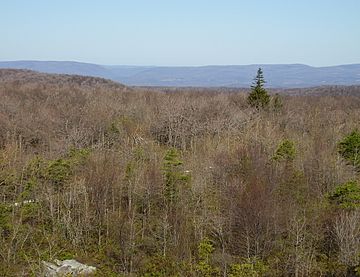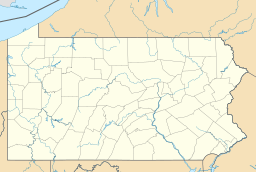Negro Mountain facts for kids
Quick facts for kids Negro Mountain |
|
|---|---|

View west from Negro Mountain highpoint
|
|
| Highest point | |
| Elevation | 3,213 ft (979 m) |
| Geography | |
| Location | Somerset County, Pennsylvania / Garrett County, Maryland, U.S. |
| Parent range | Allegheny Mountains |
| Topo map | USGS Markelton, Meyersdale (PA) Quadrangle |
| Climbing | |
| First ascent | Unknown |
| Easiest route | Drive up |
Negro Mountain is a long mountain ridge in the Allegheny Mountains. It stretches about 30 miles (48 km) from Deep Creek Lake in Maryland north to the Casselman River in Pennsylvania, United States. The highest point on Negro Mountain is Mount Davis, which is also the highest point in Pennsylvania at 3,213 feet (979 meters).
Geography and Climate of Negro Mountain
This mountain looks quite flat because it is part of the Allegheny Plateau. Even so, it stays high, often above 3,000 feet (914 meters), for most of its length, especially in Pennsylvania. The Mount Davis Natural Area is located on the mountain within the Forbes State Forest. Many trails here let hikers explore this unique landscape.
The weather on Negro Mountain can be very harsh. Frost can happen at any time during the winter. Strong winds and heavy snowstorms are also common. Near the top of the mountain in Pennsylvania, the trees are short and twisted. You can also see circular rock formations caused by something called frost heave, which is when the ground freezes and thaws.
History of the Mountain's Name
The exact reason for Negro Mountain's name is not fully known. Over the years, many local stories have been told. Most of these stories first appeared in books and newspapers from the mid-1800s to early 1900s.
Many stories share a common idea: a group of white soldiers or hunters had a fight with Native Americans on the mountain long ago. In these stories, an African-American person was with the white group. This person, sometimes called "Nemisis" or "Goliath" because of his strength, bravely died during the fight.
One of the most supported stories happened during the French and Indian War in 1756. A frontiersman named Colonel Thomas Cresap led a group against French and Native American forces on the mountain. A free black man who was part of Cresap's group was killed in this battle. According to Cresap's own account, published in the Pennsylvania Gazette newspaper in 1756, the mountain was named "Negro Mountain" to honor him. The Maryland Gazette also mentioned a "free Negro" being killed in action during this fight.
Another idea about the name is that it comes from the dark shadow the mountain casts at certain times of the day. "Negro" is the Spanish word for "Black." If this is true, the name would describe the mountain's appearance, similar to how the Blue Ridge Mountains got their name. Spanish explorers were known to have traveled in this area in the 1400s and 1500s.
Images for kids



